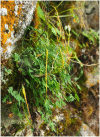The complete chloroplast genome of Meconopsis bella Prain 1894 (Papaveraceae), a high-altitude plant distributed on the Qinghai-Tibet plateau
- PMID: 38282978
- PMCID: PMC10812850
- DOI: 10.1080/23802359.2024.2306879
The complete chloroplast genome of Meconopsis bella Prain 1894 (Papaveraceae), a high-altitude plant distributed on the Qinghai-Tibet plateau
Abstract
Meconopsis bella Prain 1894 (M. bella) is a rare herb within the family Papaveraceae of which unique and gorgeous purple flowers are blooming in the flowering phase. In this study, we reported the complete chloroplast (cp) genome of M. bella, which was mainly distributed on the Qinghai-Tibet plateau. The complete chloroplast genome sequence of M. bella was 153,073 bp in size and was characterized by a typical quadripartite structure consisting of a large single-copy (LSC) region of 83,562 bp, a small single-copy (SSC) region of 178,33 bp and two identical inverted repeats (IR) regions of 25,839 bp. The genome contained 133 genes, including 88 protein-encoding genes, eight ribosomal RNA genes, and 37 transfer RNA genes. Phylogenetic analysis based on the maximum-likelihood (ML) method showed that M. bella was closely related to M. paniculate and M. pinnatifolia within the genus Meconopsis.
Keywords: Meconopsis bella; Qinghai-Tibet plateau; chloroplast genome; papaveraceae.
© 2024 The Author(s). Published by Informa UK Limited, trading as Taylor & Francis Group.
Conflict of interest statement
No potential conflict of interest was reported by the author(s).
Figures



Similar articles
-
Deciphering the complete chloroplast genome sequence of Meconopsis torquata Prain: Insights into genome structure, comparative analysis and phylogenetic relationship.Heliyon. 2024 Aug 13;10(16):e36204. doi: 10.1016/j.heliyon.2024.e36204. eCollection 2024 Aug 30. Heliyon. 2024. PMID: 39224270 Free PMC article.
-
Comparative Analysis of Chloroplast Genome of Meconopsis (Papaveraceae) Provides Insights into Their Genomic Evolution and Adaptation to High Elevation.Int J Mol Sci. 2024 Feb 12;25(4):2193. doi: 10.3390/ijms25042193. Int J Mol Sci. 2024. PMID: 38396871 Free PMC article.
-
The complete chloroplast genome of Meconopsis torquata (Papaveraceae), a traditional Tibetan medicine.Mitochondrial DNA B Resour. 2024 Jun 17;9(6):802-807. doi: 10.1080/23802359.2024.2368208. eCollection 2024. Mitochondrial DNA B Resour. 2024. PMID: 38895507 Free PMC article.
-
Complete chloroplast genome sequences of two species used for Tibetan medicines, Meconopsis punicea vig. and M. henrici vig. (Papaveraceae).Mitochondrial DNA B Resour. 2019 Dec 11;5(1):48-50. doi: 10.1080/23802359.2019.1693918. Mitochondrial DNA B Resour. 2019. PMID: 33366416 Free PMC article.
-
Complete chloroplast genome of the Meconopsis quintuplinervia (Papaveraceae), a traditional medicine of Tibetan.Mitochondrial DNA B Resour. 2019 Jul 12;4(2):2335-2336. doi: 10.1080/23802359.2019.1629343. Mitochondrial DNA B Resour. 2019. PMID: 33365531 Free PMC article.
Cited by
-
Deciphering the complete chloroplast genome sequence of Meconopsis torquata Prain: Insights into genome structure, comparative analysis and phylogenetic relationship.Heliyon. 2024 Aug 13;10(16):e36204. doi: 10.1016/j.heliyon.2024.e36204. eCollection 2024 Aug 30. Heliyon. 2024. PMID: 39224270 Free PMC article.
References
-
- Jun-Hua DU, Wen-Jing Z, Ji-Rong LI, Ying LI.. 2011. The overview of exploiture of the curatorial and ornamental resources on Wild Flora Meconopsis Vig. J Qinghai Norm Univ(Natural Science Ed). 27(04):52–57.
LinkOut - more resources
Full Text Sources
Other Literature Sources
Miscellaneous
